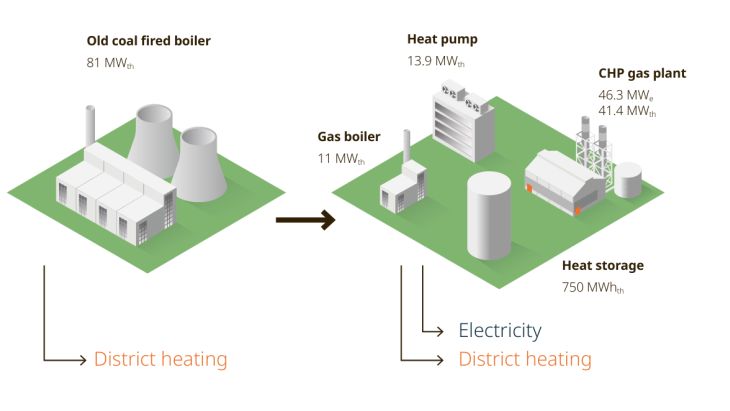Coupling Poland’s power and DH systems produces significant cost and emission benefits, saving a cumulative 3.8 billion euros and a 57% reduction in annual carbon dioxide (CO2) emissions by 2032, writes a report published by the technology group Wärtsilä. One key takeaway is the importance of establishing flexible generating assets within DH systems. Specifically, the deployment of heat pumps and Combined Heat and Power (CHP) gas engines is critical for efficiently integrating renewables resources (RES).
The report titled “Powering Poland’s Future: Optimising the Power System and District Heating for the Next Decade”, addresses Poland’s specific challenges related to the decarbonisation of its aged and inefficient coal-powered DH systems. Using PLEXOS® software, Wärtsilä has completed analysis of nearly 200 country and system studies globally to identify the optimal system designs to support the integration of renewables and reduce the system operational cost and emissions.
 “Decarbonisation of district heating is technologically more difficult than of the power system” says Louis Strydom, Director, Growth and Development at Wärtsilä Energy. “Wärtsilä’s study shows the path to decarbonisation by highlighting the importance of establishing flexible generating assets within DH systems.”
“Decarbonisation of district heating is technologically more difficult than of the power system” says Louis Strydom, Director, Growth and Development at Wärtsilä Energy. “Wärtsilä’s study shows the path to decarbonisation by highlighting the importance of establishing flexible generating assets within DH systems.”
The co-optimisation approach not only guarantees a more sustainable and efficient energy mix, but also presents the most cost-effective transition pathway to achieve this. The conclusion comes on the background of the fact that in the Polish power sector, the investments so far have mainly focused on large combined cycle gas turbine plants, overlooking the potential of coupling the power and DH sectors. Wärtsilä’s modelling results show that by co-optimising these sectors, Poland can reach several economic and energy milestones over the next decade. These include increase of the renewable energy share from 29% in 2023 to 68% in 2032 and reduction of the coal share in power production from 61% to 26% and in heat production from 80% to 8% by 2032.
A plea for CHP engines
About 3.5 GW of new power-only Combined Cycle Gas Turbine (CCGT) power plants have been planned to support the Polish grid. They are supposed to operate in a base load or a flexible base load mode. CCGTs can achieve 60% of electrical efficiency at optimal load but cannot sustain high efficiency at part load and are not suitable for cycling operations typically required in high- RE systems. Many of the planned projects are located at the sites of large existing coal plants, away from cities, where there is no or very little district heating demand. On the contrary, CHP engines fit well the vast majority of district heating networks in Poland. They can simultaneously produce electricity and useful heat, achieving total efficiency 90%. CHP engines offer exceptional flexibility, providing fast response to balance variable renewable output and quickly reacting to price changes in the electricity market, thus profitably stabilizing the grid.
The study identifies that Poland’s planned 3.5 GWe CCGT plants are not cost-optimal – excluding these could unlock an additional 1.8 billion euros in total system cost savings. Furthermore, optimised and majority renewable-powered systems can ultimately lead to lower power and heating prices for consumers over the long term.
Flexibility plays a critical role in decarbonising district heating, writes the report. “Investments channelled into a diverse range of flexible technologies are therefore paramount to achieving the cost-optimal outcome. […] Within this context, these complementary technologies include CHP engines, heat pumps, electric boilers, heat storage and BESS.
Engines and heat pumps enable the most efficient renewable integration
In the modelling, CHP engines and heat pumps emerge as the key facilitators for efficiently integrating Poland’s expanding solar PV and wind capacity. These flexible CHP engines offer a minor but powerful role in balancing the variability of RE generation across power and heat systems. Simultaneously, heat pumps serve as invaluable assets by absorbing excess RE during periods of abundance, thereby minimising curtailments and enhancing efficiencies.
For the existing coal-based baseline scenario, the modelling found that the required heat tariff to fully cover operational expenditures was 51.5 EUR per megawatt-hour of thermal energy (MWhth). However, an optimised system – characterised by a diversified mix of flexible technologies – results in a lower required heat tariff with all the simulated day-ahead (DA) electricity and gas price combinations. In all optimised scenarios, the required heat tariff to cover both operational expenses and capital expenses with a 10%Internal Rate of Return (IRR) was notably lower when compared to coal-based baseline.
An example in Poland
In almost all the optimised scenarios for OPEC Grudziądz, PLEXOS® builds 60 to 80 MWe of new CHP engines, equivalent to 5 to 7 units, together with 360 MWhth of heat storage and 11 to 17 MWth of gas boilers. The addition of heat pumps and electric boilers makes economic sense when the DA electricity price is low, and the gas price is high. As evident in the neighbouring markets of Germany and Denmark, the growing shares of RE lead to high volatility of electricity price and enable feasible heat pump investments. The DA price in Poland has already started demonstrating volatility with the price hitting zero several times per week.
A co-optimisation strategy, therefore, grounded in a more sustainable and dynamic fuel mix, maximises efficiencies and ensures system security. The result is the provision of more consistent and affordable energy across the country while advancing progress towards meeting EU climate goals.
